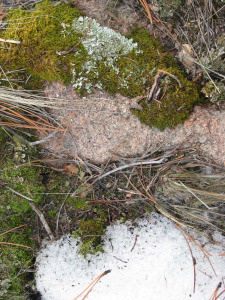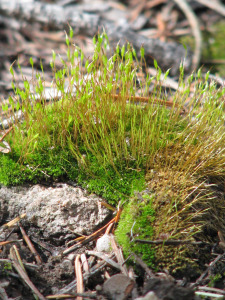Andrea M. Jones's Blog, page 15
December 31, 2014
Gauging the Weather

Moondo surveying his not-so-snowy domain on Christmas Eve.
Weather here defies pattern-seeking. High elevation and dynamic terrain make fickleness, with a propensity for the extreme, the norm. Sure, there are thunderstorms in summer, but their duration, ferocity, and direction of approach keep me guessing. The same can be said of wind, except it will kick up whenever the heck it wants to. Snow is slightly more predictable. Although possible any month of the year, it can be expected any time from November through May, and you’d be advised to be prepared for its arrival by the second week of October.
This past fall, the snow never bothered to show up, other than an inch here and half an inch there. Dry weather crisped the grass, unleashed the dust, and stirred the sort of anxiety that I recognized from years of drought. When I fretted to neighbors about the dry weather, though, several of them exclaimed in protest: “But we had such a wet summer!”
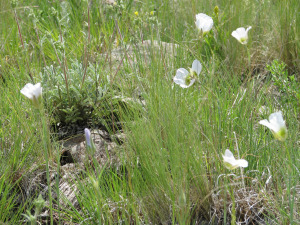
Delicate sego-lilies blooming in July.
By certain measures, that’s true enough. Late winter snows, falling in April and May as the ground was already thawing out and ready to receive moisture, brought on an early season green-up the likes of which we haven’t seen in recent memory. I’d evidently gotten used to the grass not breaking dormancy until late June, because I just could not get over that flush of early springtime verdure: so green! so soon!! Thunderstorms arrived on schedule in July and August, and the grasses and wildflowers kept their momentum. Sego-lilies bloomed for the first time in years. The horses got fat. I think everyone in the area luxuriated in a summer that was largely free from concerns about forest fires.
All of which makes it very weird to know that our local precipitation for June/July/August 2014 was 3.22 inches less than those same months in 2013, when things were crunchy and fire-prone.
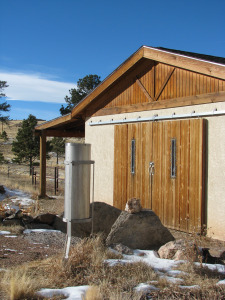
The NWS rain gauge captures snow as well as rain. In summer, precipitation is funneled into a measuring tube that fits inside the can. In winter, snow that falls into the can is melted and then measured.
I’m able to trot out a statistic of such precision because of the really big rain gauge that sits in front of our barn. I’ve been part the Cooperative Observer Program of the National Weather Service (NWS) since late 2008. As part of my five o’clock horse-feeding routine, I record data on 24-hour precipitation accumulations and high/low temperatures.
Minding the weather fits nicely with my predilection for gathering up small details about my home place, although formal data-gathering demands that I be more disciplined and systematic than is my usual habit. The obligation to take down information for someone else—and in numerical form—represents a different perspective than the casual watching I specialize in, and provides an interesting reality check. I’m never surprised when I look back at a data sheet and discover I’ve mis-remembered how wet or windy or hot a month was: that my brain is not reliable is why I write.
But the weather records also invite consideration of factors that might not have occurred to me otherwise. In looking back at the more-than-three-inch disparity between one summer’s wet “dry” and the next summer’s less wet “wet,” for example, the data pages show that there were more days with less than a tenth of an inch of rain in 2013 than there were this year. In summer heat, moisture from such brief showers is more apt to evaporate than to soak in.
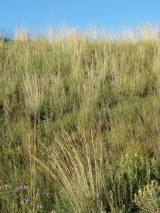 Later, though, in September 2013, the same weather system that caused massive flooding around Boulder dropped 2.38 inches of rain into the gauge. Since I was here, watching and not just recording numbers, I know that our precipitation consisted of slow rain and mist, conditions that helped send water deeper into the still-parched soil column. Coming on the heels of an improved summer monsoon and in advance of a somewhat snowier winter, then fed by a second year of decent summer rains, the effects of that old precipitation were still visible a year later, in tawny ripples of grass ripening on the slopes hereabouts.
Later, though, in September 2013, the same weather system that caused massive flooding around Boulder dropped 2.38 inches of rain into the gauge. Since I was here, watching and not just recording numbers, I know that our precipitation consisted of slow rain and mist, conditions that helped send water deeper into the still-parched soil column. Coming on the heels of an improved summer monsoon and in advance of a somewhat snowier winter, then fed by a second year of decent summer rains, the effects of that old precipitation were still visible a year later, in tawny ripples of grass ripening on the slopes hereabouts.
After paltry snowfall in October (0.5 inches) and November (3.2 inches), the big silver NWS can in front of the barn is getting a workout again, finally. The Christmas Night storm that dumped on other parts of Colorado gifted us with 3.4 inches of snow. That was soon followed by another 8 inches, carried in on a cold front (daytime high of -7 degrees on December 30). In the space of a few days, the four-month period of September through December of 2014, which was on track to be the second-driest in eight years, suddenly looks like it will end up merely on the low side of average.
Ditto for the total precipitation 2014: still fickle, but for this year, at least, avoiding the extreme. 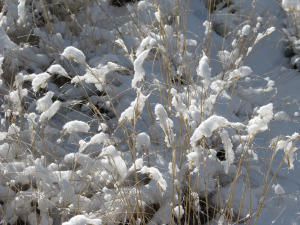

December 8, 2014
Dusk
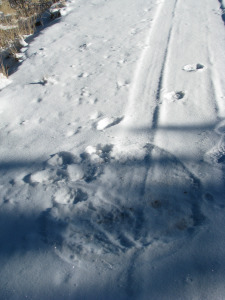
The scuffed impression showing where the mountain lion lay down.
A couple of weeks back, after about a half-inch of snow had fallen overnight, Doug came back inside from feeding the horses their morning hay with a report: “Ummm, I’m pretty sure there are cat tracks on the driveway,” he said, “And it looks like it lay down, too.”
I booted up and went outside to take a look. Yup. Mountain lion. Not big, but clearly present and evidently quite at home, judging from the loosely curled body print on the driveway. Seems the cat took a little break, settling down for a spell to take in the view down the slope overlooking the back of the barn and the barn pasture.
I’m not astute enough to notice the subtle impressions left by feline paw pads on gravel, grass, or pine needles, so I’m less likely to notice that a mountain lion has been around in summertime. I know they’re here year-round, and from a philosophical standpoint I deeply appreciate that fact. Like the ponderosa pines and the mule deer and the Clark’s nutcrackers, mountain lions are rightful citizens of this place, and their presence signals that the hillsides we live on are part of a functional ecosystem.
Because snow provides a blank canvas that automatically records their passage, when we do find the rounded florets of mountain lion paw prints, it’s usually winter. Most often, we come across tracks about a half-mile northwest of the house, where a gravel road that makes for an easy stroll on a wintry day cuts through a stand of evergreens. The recent set of prints marked the first time since we’ve lived in the house that we’ve seen mountain lion sign so close to home.
Time spent outside is, for me, usually time spent thinking and looking, but my mind’s trajectory during my evening walks down to the barn have, of late, been unusually organized. I’m not merely looking with a neutral eye, to see what there is to see. I’m looking for something—specifically, for tawny hide or a pair of front-mounted predator’s eyes. It’s a different style of attention.
I feed around 5:00 p.m.: in broad daylight in summer, at sunset in these foreshortened winter days. Mountain lions are crepuscular: they’re most active at dawn and at dusk. Our driveway cuts through a fringe of trees strung along a finger of ridge that extends between the house and the barn. Mountain lions are ambush predators, preferring to lie in wait in woody or rocky areas until prey passes nearby. The mountain lion that paused on its journey was small, which means it was probably young. As a youngster out on its own, I wonder, is this cat cautious, naïve? Or is it bold and cocky, an on-top-of-the-world punk? I consider whether it was just passing through or was perusing this as potential home territory—we have ample deer around, after all. I catch myself thinking how slow and clumsy I am in winter boots and promptly get annoyed at myself. You aren’t supposed to run, you dimwit. Look big. Yell. Fight. Don’t run.
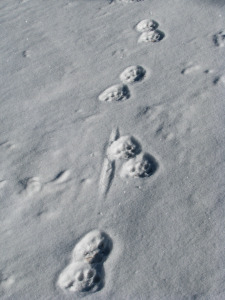
Heading north.
Crossing the path of the mountain lion—the tracks long gone, the trail, so far as I know, long gone cold—I think about the thing I like to say about mountain lions, which is that anyone living around here has been seen by a lion far more often than they’ve seen one.
I still believe that’s true. The mountain lions are here, even if we almost never see one and only rarely spot their tracks. As canny predators, they’re observant. As ambush hunters, they’re practiced at discretion. As I go about my routine these days, keeping my evening appointment with the horses, I have to confess that I can’t help contemplating the possibility that there’s a set of feline eyes calmly watching me from behind a shoulder of rock or a screen of branches. Noting my habits.
For a week or ten days after Doug and I saw the tracks, the horses were, unsurprisingly, nervous and snorty. They eventually settled down, and I’ve been drawing an extra element of comfort from their relaxed demeanor around the barn, from the rhythmic grinding of their jaws as they chew their evening hay. Such serenity makes for a relaxed walk back to the house, through the gloaming and through the trees. The next time horses jog in hungry but skittish, spooking in short runs to stare up the ridge or down the draw, pausing in their chewing and holding their breath to listen intently…well, I’ll still walk back up to the house, but I don’t know that that the journey will be a relaxing one.

November 13, 2014
End of Season Miscellany
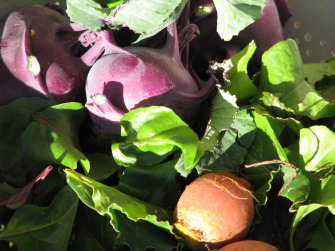 The season is over. The potatoes are dug, as are the carrots and the dinky onions. The kale, while green right up until an arctic front settled over us and drove temperatures below zero, is done for the season.
The season is over. The potatoes are dug, as are the carrots and the dinky onions. The kale, while green right up until an arctic front settled over us and drove temperatures below zero, is done for the season.
The leaves of the cherry tree abruptly turned and dropped last week, after having lingered for the two months since our first frost on September 11. I ate one cherry off that tree this summer. By the time I’d noticed that the Stellar’s jays and robins and who-knows-what other birds had finally, after almost a decade, figured out that tart cherries are tasty, there weren’t enough left on the tree to cook anything with. I ate my lone cherry just to maintain my claim, and let the birds have the rest.
Although I potted up tomato seeds and managed not to kill off the seedlings during hardening off, as is my habit, the plants were slow to get going and were just hitting their stride in early September. So: no home-grown tomatoes on our salads this year.
I did manage to pick one zucchini before the plant froze.
The horses are finally getting their share of the garden crops, though: carrot tops. My little red horse Moondo is fond of bitter greens, and eats his daily handful of wilted fronds with enthusiasm. Jake, my husband’s big gray, has a sweet tooth and is less appreciative. He’ll accept the greenery, but the look on his face calls to mind that of an eight-year-old boy who has just unwrapped a package of tidy whities on Christmas morning: Really? This is what you got for me?
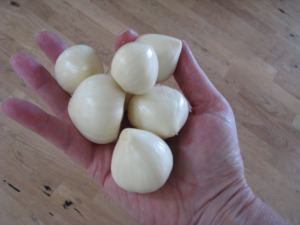
Some of my giant garlic cloves.
After neglecting to plant garlic last fall, I broke up a few old heads and shoved the cloves in the ground in late spring to see what would happen. The tops quickly popped up, the green spears stretched…and then withered early. The resulting harvest of a couple dozen heads seemed like a good outcome, although half of the heads didn’t bother to divide into cloves, just swelled as single massive bulbs the size and shape of figs. And for whatever reason, the garlic itself turned out to be dynamite—as in powerful. When I used one half of one (normal) clove in a roasted eggplant dip, the result was so potent that we couldn’t eat the stuff, and I ended up using the dip to thicken a soup. I regarded the remaining garlic heads with trepidation for while, before deciding to cook the whole mess down in my version of roasted garlic. I broke up all the heads, peeled the cloves, cut the oversized ones down, and simmered it all slowly in olive oil, ending up with a quart of garlic confit packed in flavorful oil to use over the next few months.
I usually do well with beets, which I like growing both for their ease and because they’re a two-fer—or a three-fer, depending on how you look at it. I pinch leaves off for salads and sautés throughout the summer, before harvesting the beetroot, at which point I’ll get more greens. When I went to clear the beet patch, I pulled up two golden beets about the size of a ping-pong ball; all the other plants weren’t much bigger than seedlings. The full crop of baby greens went into a single potato-and-dinky-onion hash—and even then I needed to supplement the greenery with kale.
And so it goes. The misadventures stack up, partly a result of a harsh environment and short growing season, but also due to the fact that I am my own gardening challenge. I plant too late, am stingy with water, especially when memories of drought years are still vivid. I’m not vigilant when it comes to pest management, staking, pruning, thinning. I make the same mistakes over and over.
But the failures always seem to match up with, if not a success, then an oddball surprise. The crate of multicolored potatoes made up for the lost beets. The birds ate the cherries, but they still haven’t learned to go after the tiny white alpine strawberries. For the lettuce and spinach that didn’t bother to sprout, there’s red kale…and dinosaur kale. Although frost killed the tomato plants, most of the green tomatoes were basically unscathed, so I picked them, cooked them down, and stashed them in the freezer for baking experiments this winter. And, as they usually do, the snow peas grew, produced, and grew some more. Underneath a canopy of frostbitten foliage, new tendrils and even blossoms have kept unfurling since September. I picked a colander full of the most tender of the new shoots, and on the same day I called the garden season at an end, we dined on bright green pea tendrils. Whether their herbal notes on my tongue were a reminder of this past spring or a promise of the coming one, I can’t quite decide.


October 27, 2014
Homebody on the Road
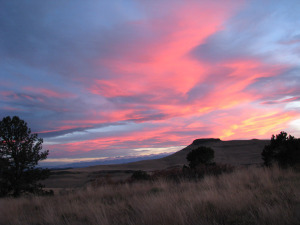
Home Again: An October sunset blazing on the southern horizon.
I don’t get out much.
This is intentional and by nature. I enjoy the vast good fortune of a life that revolves around a home place in a beautiful natural setting. I work from home, and my husband and I continually strive to arrange our leisure time to include activities that do do not require getting in a car.
Still, there are good reasons to get out now and again. As much as I love the landscape around me, a change of scene can be refreshing and the pleasures of socializing sometimes demand that I’m the one that hits the road. Both of my primary vocations—writing and indexing—are solitary endeavors, and mixing with colleagues who also spend their working days alone is uniquely invigorating. This fall, it just happened that all of the very good reasons for getting off the property happened to converge, with four different trips and gatherings crowding onto the calendar during September and October. All were events I looked forward to—a writing retreat, a vacation with my husband, an indexing workshop, a writer’s conference. And even though a perfectly aligned universe would have placed them on a schedule more evenly spread out, I suspect that such a universe might turn out to be rather dull.
And so I left for the first trip on September 8, arriving home from the last one on October 19. I’d slept twenty-three of the intervening nights away from home, had been gone six Saturdays running. As I puttered around the house this past weekend, I realized I wasn’t either preparing to go somewhere or catching up from having been gone for the first time in almost two months.
Re-entering the rhythms of my homebody lifestyle after a fair absence gives me renewed appreciation—which is part of the point of getting away, of course. What’s weird about my existence is that my everyday routine accommodates reflective time, wandering outside without a set destination or goal, and slow reading of physical books composed of ink and paper—the sort of quiet activities that most people crave and seek in their limited and precious getaway time. Rather than scavenging serenity, my life-work balance challenge involves seeking out the loud, urban, and hyper-connected world now and again. Otherwise, I risk allowing my private-universe life to settle below the event horizon of self-absorption’s black hole.
The past couple of months have been intense, particularly coming on the heels of The Busy of the summer. And although I regret not having more time to process all the conversations and sights and presentations and sounds and mentoring while it was all going on and fresh in my mind, I can look forward to the slowed pace of the approaching winter days. I’ll be able to savor a different sort of harvest than the potatoes I dug yesterday, but the principle is the same: tapping into an abundance salted away for later sustenance.


September 18, 2014
The Busy
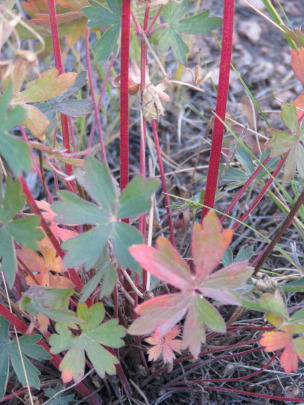
Late summer sticky purple geranium.
A fringe of scarlet on the leaves of a Rocky Mountain maple. The fade to gold in the cottonwoods. A landscape gone tawny under sun-cured grasses. Short glossy hairs dropping off the horses, replaced by fuzz. Frost-blackened leaves curling on the beans, the squash, and the tomato plants.
All of which raises the question: Where did summer go?
Sure, fall doesn’t officially kick in for a few more days, but my body knows it’s here. The sun’s seeking a lower angle to my eyes. I close the hall window at night. It’s still dark when I wake up in the morning. I walk outside and smell hay and dust, not greenery and damp soil.
I had grand plans for the summer: to ride the horses, to give the garden more care and nurturing, to hike more, to spend more time reading on the deck, to go camping. Instead, I found myself embroiled in a daily litany of Gotta-do. The everyday chores of house and garden just barely fit in the open spaces between work, houseguests, errands in town, and one fairly significant home improvement project. True, I did begin work on a new writing project, which filled in the crannies of available office time. And there was a sick horse here and a computer meltdown there. Still, I found myself collapsing in the chair each evening, weary and sore, confused and exasperated: How was it that all the bustle had barely whittled away at the daily list?
When I try to reconstruct what, exactly, has kept me in an incessant state of overwhelm for months, I’m mostly at a loss. Yes, there was the blizzard of book pages as multiple indexing projects landed on my desk simultaneously, just as company was arriving and in the midst of the long-overdue rebuilding of the tile roof deck. But that was July. Whither June? And August?
I blame the weeds. After several years of drought, a pretty normal winter and wet spring snows were followed, after a parched June, by a decent monsoon season that brought on wildflowers and grasses galore. Unfortunately, the weeds have been just as exuberant, if not more so. And so I mowed the roadsides. I weed-whacked weedy patches in the horse pastures. I grubbed up undesirables in the garden and landscaping beds with a spade and a dandelion fork. I sprayed distilled vinegar. And I pulled. And pulled. And pulled.
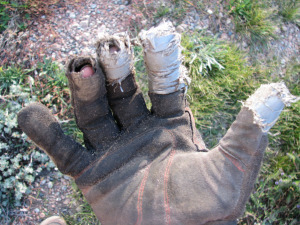
Weeding gloves; a few new duct tape patches and they’ll be good as new.
And I’m pretty sure that’s where my summer went. To peppergrass and cheat grass, to kochia and lamb’s quarters and bindweed. To yellow sweetclover, western sicktights, redroot pigweed, tumbleweed, Canada thistle, and hoary cress. I spent hours at a stretch getting dusty and sweaty, wearing holes in my gloves that I patched, over and over, with duct tape. My back ached, my hands hurt, my hamstrings burned.
The weeds will be back next year, of course. Not as many as there would have been, but the pesky hordes will return to taunt me with their easy-growing ways and their profuse seeds.
I weed because I think it matters, because I believe persistence and incremental progress will give the native plants more opportunity to make good use of the space and water opened up to them. But when I’m being more deeply honest, I’m forced to admit that the weeding chore also floats to the top of that interminable to-do list because I like weeding. Maybe not for six to eight hours a week, which is what I reckon I averaged this summer. And not using the mechanical methods, with a mower engine howling in my ears or trimmer motor vibrating my knuckles. But pulling and digging are curiously satisfying. Keeping aggressive invaders at bay gives me the sense that I’m doing my part for the landscape. I enjoy the time spent outside.
And unlike time spent indexing or writing or catching up on the bookkeeping, weeding leaves my mind free to wander. Weeding has become meditative: I feel like I’m present in my life, yet also gently detached, walking on a parallel path for a time. I’m still making headway, still getting something done, but the work is easy. The motions are familiar and, for the first hour or so, I feel capable and fit. I’m “busy” doing something I think needs doing, which silences the inner voice that’s usually screeching about the next chore on the list. And since the task is endless, the satisfactions that come of it are in the doing, not the having done.


August 13, 2014
A Preponderance of Purple
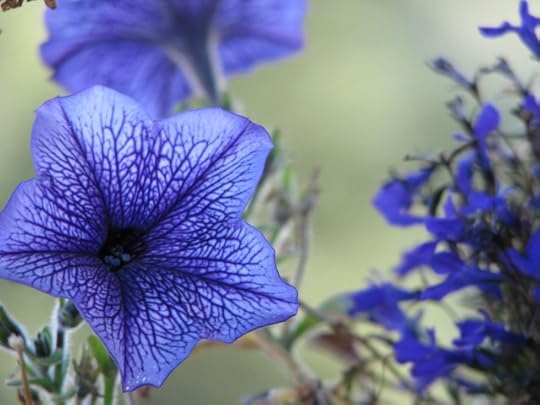 My tastes don’t generally run toward clear favorites or coveting the “best” of this or that. I favor variety and contrast and have a tendency to be suspicious of my strongest biases, regarding them with clinical curiosity to trying to figure out where they’ve come from and whether they’re worth hanging on to.
My tastes don’t generally run toward clear favorites or coveting the “best” of this or that. I favor variety and contrast and have a tendency to be suspicious of my strongest biases, regarding them with clinical curiosity to trying to figure out where they’ve come from and whether they’re worth hanging on to.
Evidently, though, I have a strong preference for purple when it comes to landscaping with flowering plants. I noticed this a few years ago, when the garden was in its early summer blooming phase. While the vegetables were still ramping up, many of the ornamentals were in full floral regalia: iris, May Night Meadow Sage, Rocky Mountain penstemon, Corsican pansies, violets—all with purple blooms. As the summer wore on and more plants came into flower, the trend continued with lavender, Echinacea, and a native milk-vetch that volunteered to weave its leaves into the silvery Partridge Feather groundcover. The rose-magenta tint of tiny blooms carpeting the creeping thyme and the wine-colored cups on the Poppy Mallow added to the widespread purple vibe.
Inside the walled garden’s confined space, the skew toward the ultraviolet end of the color spectrum was pretty remarkable, and visitors did remark. So I launched a program to bring in other colors, seeking yellow, white, pink, or red flowering plants. It took a few years to improve the balance, which is, I’ve found, still somewhat delicate. I arrived home from town this spring with two four-packs of adorable violas I’d fallen in love with at the hardware store. The second I walked into the garden, I had a Homer Simpson moment: “Doh!!” Purple, of course, which I hadn’t registered until too late. But in my defense, the violas are a most charming blend different shades of purple.
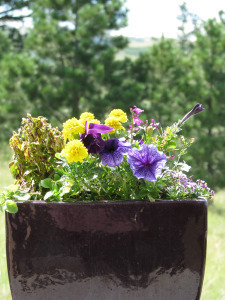 My proclivity for plummy shades is evident up at the house, too, where annuals spend the summer in pots (a number of which are, yes, purple-glazed) near the doors. Each container hosts a different mix, but there’s purple in all of them: petunias, pansies, a striking delphinium. Even plants I don’t grow for their flowers pitch in when in bloom, with culinary sage, catmint, lamb’s ears, and Russian sage each contributing their flowers to the lavender-to-purple summer show.
My proclivity for plummy shades is evident up at the house, too, where annuals spend the summer in pots (a number of which are, yes, purple-glazed) near the doors. Each container hosts a different mix, but there’s purple in all of them: petunias, pansies, a striking delphinium. Even plants I don’t grow for their flowers pitch in when in bloom, with culinary sage, catmint, lamb’s ears, and Russian sage each contributing their flowers to the lavender-to-purple summer show.
This year, we enjoyed an early flush of native wildflowers following our spring snows, and July monsoons have elicited an enthusiastic second act. As I wandered around and admired the floral gems, I noticed that my partiality to purple is apparently shared by the pollinators that have helped push the evolution of the local wildflowers. Although their bloom times are scattered, the flowers of the following native plants all lie somewhere along the purple spectrum:
harebells
pasque flower
lupine
showy locoweed
penstemon (several varieties)
blue flag iris (a misnomer, if you ask me; the flowers are lilac-hued)
sugarbowl clematis
closed gentian
spider-flower
sticky purple geranium
purple aster
milk-vetch (again, several varieties)
showy aster
Rocky Mountain clematis
prostrate vervain
blue lettuce (again, I’ll advocate for a lavender-leaning color classification)
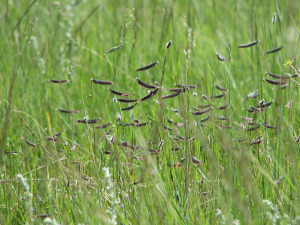
Blue grama grass.
Weedy non-natives alfalfa and Canada thistle deserve a passing mention on the basis of their flower color. And depending on how you slice the rainbow (and who would be so heartless, or presumptuous?), I’d include nodding onion in the family of native purple flowers—it’s blooming profusely right now, sending up airy flower clusters that resemble miniature starburst fireworks gleaming lilac-pink among the grasses. And speaking of grasses, I should also include blue grama grass: the seed heads currently periscoping above the narrow leaves aren’t aiming to attract pollinators, but they’re a deep maroon-purple, like the residue of a hefty cabernet in the bottom of a wine glass. Similarly, the new pine cones on the Ponderosas are indubitably purple.
On the basis of all this, I’d say that my tastes are not freaky or eccentric, merely in tune with the local environment. I’ll continue to strive for variety, but will take comfort in the fact that being pleased by purple puts me in some good company.
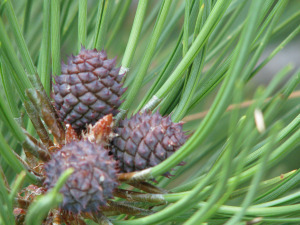
Ponderosa cones.


June 26, 2014
On Being Watched
For the most part, the wildlife around our place regards me with either fear or wariness. Birds flutter, squirrels scurry, deer bound. The latter, admittedly, only retreat to their calculated safe distance before turning to assess my intentions, but all of them move away when they detect my presence.
Except the ravens. They don’t fly when I walk out the door. They’re not fearful, or indifferent. The ravens aren’t merely desensitized to the human comings and goings around the house, carrying on with their business as usual as we carry on with ours. Instead, it seems that we—and me, in particular—have become part of their business as usual.
A common scenario is that, a few minutes after the side door in the garage bangs after me as I walk inside, I’ll see a raven cruise past a window, gliding low over the hillside below the house. At close range, I can see the bird’s head swiveling slightly as it scans the ground below. I know what it’s looking for. We’re constantly tweaking our efforts to keep mice out of the garage, but they persist in chewing through the rubber gaskets on the bottom of the garage doors, so we haven’t yet succeeded at permanent exclusion. I don’t use poison, but I reserve the right to be territorial when it comes to rodents inside the house, so I do set traps. When I catch a mouse, I open the door and flick the little carcass over the hill, where a heavy black beak will soon snap it up.
During the winter, I feed the horses grain inside the barn, but come summertime they dine alfresco. The ravens are familiar with this routine, and at least one shows up each day, waiting atop an electric pole or a ponderosa pine while I schlep feed pans out to the pasture and wait for the horses to eat. Before I’ve reached the barn to stow the empty pans, the raven will be on the ground, gleaning dropped grain. The bird will then set out for the nest site tucked away in the woods east of the house, a full crop bulging at its neck like a goiter. Later in the summer, the young ravens will join their parents for the dinner picnic. These are extremely noisy events, with kids and parents yelling in each others’ faces as if they were auditioning for a reality TV show about families behaving badly.
I’m not keen on my status as a walking dinner bell, but I take some comfort in the fact that I’m hardly unique in being the object of corvid attention. A dozen years ago, when our house was under construction, I was regularly amused to watch the afternoon commuter traffic: ravens flying in to the house site as contractors’ pickups were driving out. The ravens sorted through the top layer in the dumpster, searching for leftovers from lunches and snacks.
Scavenging is one of those ecosystem services that occupies a blind spot for many Americans, but I think the relationship is more nuanced than ravens acting as our garbage-pickers. In his book, Mind of the Raven, biologist Bernd Heinrich reports that ravens in the Arctic don’t just follow hunting parties and wolf packs, waiting for the opportunity to scavenge at a kill, but are believed by some to act as lookouts from their vantage point in the sky, indicating the direction of game animals with a dip of a wing. I’m not a hunter, but in the regularity of my routines I might be something even better in the ravens’ eyes: reliable.
Familiarity has a way of inviting, in the human species at least, speculation about the minds of others. A few summers ago I thought I had deciphered a four-note raven call. The vocalization was distinctive and more musical that your average croak, so I figured it must mean something. When I first became aware of it, I saw a hawk or eagle nearby. Theorizing that the call signified a raptor in the area, I would scan the sky and treetops when I heard it. Those early incidents were evidently coincidence, because once I started looking, I never saw a raptor in association with the call again. Forced to revise my theory, it occurred to me that if I often heard those four notes when I was outside, then they might actually signal my presence in the area.
I admire that the ravens so openly flip the usual wildlife-human interaction by approaching rather than fleeing. I’m less at ease with being the watcher who has become the watched. It’s doubtful the ravens are quite so specific, but the possibility that they’re not just watching, but talking about me, too…I’m pretty sure I’ll never get used to that.


May 14, 2014
Shoveling Water
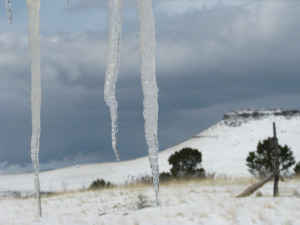 Spring snows don’t last long. The sun has a better angle for its rays—and more hours in the day—to use against the accumulated white. The air temperatures are higher. And the ground is no longer frozen but is itself a heat source, a broad expanse of thermal mass slushing the snow steadily from below.
Spring snows don’t last long. The sun has a better angle for its rays—and more hours in the day—to use against the accumulated white. The air temperatures are higher. And the ground is no longer frozen but is itself a heat source, a broad expanse of thermal mass slushing the snow steadily from below.
Blizzard conditions on Sunday, May 11, blanketed the area with another dose of wet and heavy snow. Even though I knew it wouldn’t linger, I spent a couple of hours on Monday lugging sloppy scoops from the hard surfaces of walkways and decks and patios, tossing the snow onto flowerbeds, the raised beds in the garden, the grasses and groundcovers and herbs near the house. This is more or less the same principle as a downspout rain barrel, only a lot more labor intensive.
The week before the Mother’s Day snowstorm, I was in Charleston, South Carolina, to attend an indexing conference. I stayed on afterward for a few days with my Mom, who flew down from New York to join me. While spring goes through its stuttering dance here—from 70˚ on May 5, our daytime high dropped to 26˚ on May 12—in Charleston, spring was all but finished: the azaleas had already flared and faded weeks ago, and Mom and I donned sunscreen and sought shade as temperatures hit the mid-90s. The heat was abrupt to both of us, still recovering from our respective long winters.
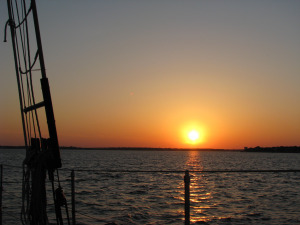
Sunset over Charleston Harbor.
We toured historical sites, but spent much of our time exploring the area: strolling in gardens, hiking a winding boardwalk trail through a swamp, visiting a riverside park. On a boat tour around a former rice field cleared and worked by slave labor, we spotted alligators and watched great blue herons while a pair of osprey eyed us from above. We took a sunset sail on Charleston Harbor. On most of our walks and while driving from place to place, the views were closed in by a thick growth of trees and vines. Every long vista I saw had a river or a swamp or the ocean as its base. Water everywhere.
And now, back home in my high-altitude office, I look out at the snow-clad landscape while icicles drip from the eaves.
Water everywhere, for now. The snow, as I said, will not last long. It was already shape-shifting as it landed, flakes going liquid, uniting with dust to synthesize mud, evaporating on the wind. Meltwater from the accumulated drifts will vanish downhill, will percolate into the porous and thirsty ground, trickle into the tunnels of pocket gophers and voles and moles and ground squirrels, filter between the fine crumbs of decomposed granite.
From its secret pores and fractures the water will morph again, absorbed by the eager roots of fescue and piñon and ponderosa pines—and by the alpine strawberries, the cherry tree, the asparagus, and the rhubarb, all pressed by the extra weight of the snow I shoveled onto them.
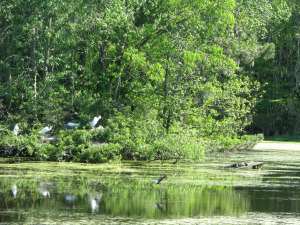
Audubon Swamp at Magnolia Plantation and Gardens.
On my sojourn in the South, it was easy to see the greenery around me—the walls of trees, the expanses of reeds and duckweed, the eruptive plumes of palm fronds—as proxies for the fundamental wateriness of that place. I don’t see the plants of home this way, as expressions of water. Yet I regularly mark their responses to precipitation, and I elect to shovel water as a way of directing a scarce resource so the plants can take advantage of it.
I took the time and made the effort to move the snow because my home place has trained me not to take water for granted. Visible surface water is scarce here, small-scale and seldom-seen. I feel the water, though, when it comes. I feel it inside my nasal passages and on my skin. I feel it in my chest during the exhilaration of a summer rainstorm. I feel it in the ache of my elbows after a day of springtime shoveling,


April 28, 2014
Opportunism
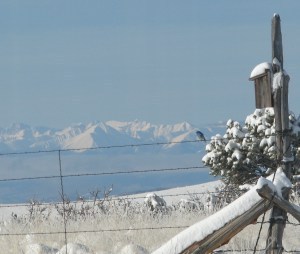
A fluffed-up male Mountain Bluebird waits for the sun to do its work.
I know spring has arrived when the bluebirds stay put for snowstorms, toughing it out through the white and wet instead of moving down to lower elevations to avoid the cold.
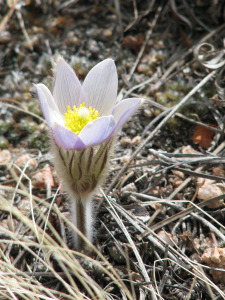
Pasque flower.
Three different storms dropped snow in the first three weeks of April, and I felt for winter-weary friends in the East as the weather systems headed their way. I didn’t have anything to complain about though; snow is par for the course up here this time of year. In fact, since we’ve been stuck in drought conditions for a couple of years, I was tracking the forecasts and cheering for more snow instead of less. What we got was a modest bounty of wet: increments of precipitation substantial enough to wet the sleeping roots of plants instead of sublimating uselessly in the wind. By the time the second five-inch snow was melting into the thirsty topsoil, thin blades of grass were pushing up through the slush.
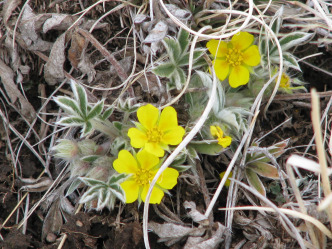
Cinquefoil.
My walks and wanders over the past week or so have been rewarded with flecks of green and the occasional gleam of an early wildflower—vibrant outbursts against a backdrop of tan cured grass or old brown pine needles. It took me a while to realize that I was getting so excited at these tiny vernal flares because I haven’t seen the like in a couple of years. Last spring was the worst, less a season of hopeful new beginnings than an ominous litany of dust. The grass didn’t start showing new growth until thunderstorms arrived in June.
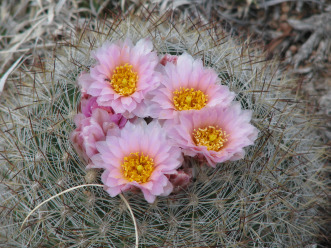
Ball Cactus in bloom.
I wasn’t surprised to see pasque flowers on my meanders last week—this is a plant so eager to get blooming that it doesn’t take the time to form leaves until later. The cinquefoil are also early risers, nestled in the shelter of warming rocks out on the treeless ground of the pasture. I was surprised, though, to find ball cactus spraying pink fountains of petals. And I didn’t expect to see, down among the trees on the north-facing slopes where snow was still receding from isolated banks, mounds of moss glowing with an emerald intensity that made me squint.
The environment of my home place is, despite its elevation, best described as semi-desert. I am reminded of this fact as I watch plants taking advantage of the recent precipitation. Theirs is opportunism in the sense of expediency rather than exploitation: organisms suited to their place, ready to make good on propitious conditions, regardless of the calendar month.


April 7, 2014
Losing the Garlic
For the first time in five or six years, I haven’t lost the garlic.
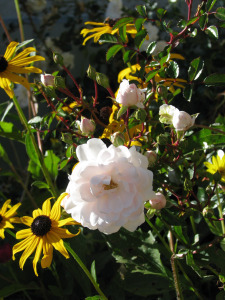
2008: The rose has since been transplanted, after it began taking up too much room in the small garden space.
I plant it in the fall, breaking a few heads up into individual cloves and digging them in like little bulbs. The garlic bed shifts from year to year, as do the locations of most of the garden crops. My riff on crop rotation is a nod to keeping plants and soil healthy, but really I just like the variety. The garden isn’t set up for linear plantings, and I enjoy playing with different combinations and layouts within the framework set by the raised beds and the permanent plants like the tart cherry tree and the ever-sprawling bed of alpine strawberries.
There’s an element of improvisation to the garden, a serendipitous quality that builds up through the summer until it finds full expression in August, when the tightly-planted beds overflow in a feral exuberance of greenery and blossoms.
In the context of this free-form approach, fall-planting garlic stands out as an exercise in advance planning. Since being proactive is not exactly one of my strong suits, I’m always unduly pleased with myself when I manage to accomplish something along those lines. I also like the fact that this one project at season’s end, when gardening tasks are mostly about closure and putting things to rest, requires projecting my mind ahead to the next year, to new beginnings.
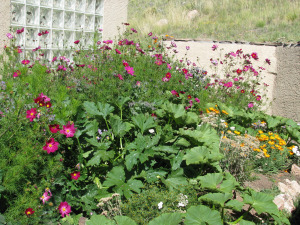
2010: A banner year for the border garden.
Of course, laying plans is not the same thing as making good on them. Once I plant the garlic, I turn off my gardening mind for a few months. March and April are not gardening months up here, but the signs of spring are sufficiently evident to switch on the lights in the little alcove of my brain that likes to grow things. I peruse the seeds I want to plant and start sketching what will end up where.
Which is when I inevitably find myself wondering where I planted the danged garlic. It seems like it will be so obvious, on that fall afternoon when I’ve tucked each aromatic clove in its winter bed. A few months later, I’m looking at the beds, with blown and shattered fibers from last year’s beans and tomatillos strewn over the frosty dirt and dirty shreds of old icy snow, and haven’t got a clue.
The garlic rescues me, though, fulfilling its side of the bargain from the previous fall. Long before I’m ready to put seeds in the ground, the garlic sprouts, announcing its location with slender green shoots.
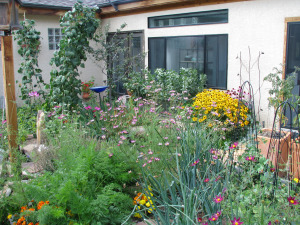
2012: Best year ever for beans…and not bad for flowers.
This year, as I said, I haven’t lost the garlic. But this isn’t because a proactive burst met an organizational impulse, leading to me jot a planting note. I haven’t lost the garlic this year because I never got around to planting it in the first place.
I’m trying to convince myself that the blankness of the garden’s slate this year compensates for my lack of effort last fall. This will be a worthwhile experiment, I tell myself, seeing how the garlic fares if it’s spring-planted. I’m usually late to harvest the stuff, anyway, so maybe things will work out and I’ll have perfectly formed and ripened bulbs to show for my lack of diligence last fall. But on these April days, when the wind blows cold and the muddy beds of the garden look vacant and forlorn, I’m missing the promise and the mettle personified by those straight little green shoots, growing taller day by day.
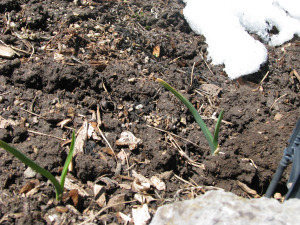
Garlic shoots pushing through a snowy spring.



